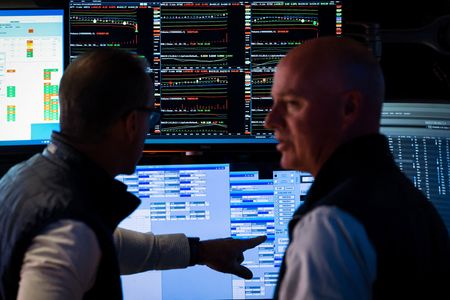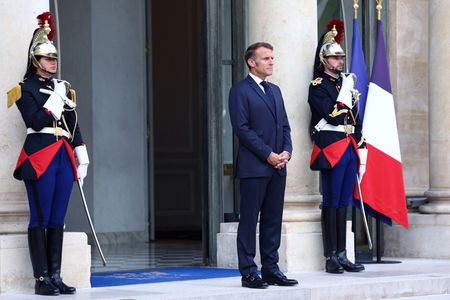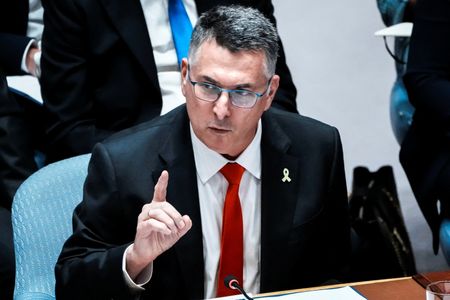By Jamie McGeever
ORLANDO, Florida (Reuters) -TRADING DAY
Making sense of the forces driving global markets
By Jamie McGeever, Markets Columnist
The S&P 500 hit a record high on Wednesday, as Wall Street rose broadly on expectations the Federal Reserve will lower interest rates next month and on investor confidence that tech giant Nvidia’s results would deliver another resounding ‘beat’.
More on that below. In my column today, I look at examples of where the overt politicization of monetary policy has had severe economic and market consequences. And contrary to perceived wisdom, these have not just been in emerging markets.
If you have more time to read, here are a few articles I recommend to help you make sense of what happened in markets today.
1. Fed’s credibility is an asset whose decline could becostly 2. The fight for the Fed reaches its decisive moment 3. India hit by U.S. doubling of tariffs, plans to cushionblow 4. Tariff-bolstered U.S. credit rating is still tarnished:Mike Dolan 5. Investors worry Trump’s Intel deal kicks off era of U.S.industrial policy
Today’s Key Market Moves
* STOCKS: S&P 500 hits new high. China’s benchmark indexesslump 1.5% or more. Europe flat, Britain’s FTSE 100 falls for asecond day from Monday’s record high. * SHARES/SECTORS: Nvidia shares fall as much as 5% inextended trade after earnings, despite beating on Q2 revenue andforecasting strong Q3 revenue on robust AI chip demand. * FX: Dollar index gives back gains, ends flat. In G10space, dollar falls most vs Canadian dollar and Norwegian krone. * BONDS: French 30-year yield highest since 2011. U.S.2-year yield falls to 3.62%, lowest since May. 5-year auctiongoes reasonably well. * COMMODITIES: Oil rebounds 1% plus from Tuesday’sselloff. Brent crude futures have now swung 1% or more in nineof the last 10 trading sessions.
Today’s Talking Points:
* Wings of a dove
Investors remain confident that the Fed will cut interest rates next month as the controversy around President Donald Trump’s attempts to fire Fed Governor Lisa Cook persists. Traders are putting a near-90% probability on a move next month, and the 2-year Treasury yield fell to its lowest since May.
New York Fed President John Williams said rates are probably headed lower, but officials need to see more economic data before deciding if a cut next month is appropriate.
* Stock rotation
The S&P 500 clocked a new high on Wednesday, led by the energy and healthcare sectors. As August draws to a close, the rotation into small cap and value stocks from tech and growth stocks shows no sign of reversing.
The Russell 2000 index has lagged all year but on Wednesday notched a new 2025 high, again outperforming Wall Street’s big three indices. Will this continue next month? Much will depend on the impact of Nvidia’s Q2 results, and expectations of what the Fed will do on September 17.
* China takes stock
Chinese stocks have been on a tear, roaring to decade highs earlier this week. But the AI-driven rally sputtered on Wednesday, and the Shanghai Composite slid nearly 2% for its biggest fall since the tariff turmoil of early April.
It may just be natural profit-taking as month-end looms. But maybe the rally is stretched – Hong Kong’s tech index is up 10% in August and up 60% from the April low, and China’s economy is still not out of its funk: China’s economic surprises index last week fell to its lowest level this year.
Danger ahead! Five examples of risky central bank politicization
There is legitimate debate about the actual independence of modern-day central banks, but almost everyone agrees that overt politicization of monetary policy – as we appear to be seeing in the United States – is dangerous. Why is that?
Central banks are essentially arms of government, and many worked in close conjunction with national Treasuries in response to the Global Financial Crisis and pandemic, so absolute independence is a bit of a myth.
But what U.S. President Donald Trump is currently doing goes well beyond that. By threatening to fire Chair Jerome Powell, actively trying to sack Governor Lisa Cook, and attempting to fill the Board of Governors with appointees sympathetic to his calls for lower interest rates, he is shattering the Fed’s veneer of operational independence.
Examples of the naked politicization of monetary policy down the years show that it can, to put it mildly, deliver sub-optimal results – loss of credibility, currency weakness, spiking inflation, rising debt, elevated risk premia, and, potentially, much higher borrowing costs.
These are certainly far from guaranteed outcomes in the U.S., but they show where excessive political interference in monetary policy can lead.
TURKEY
“Erdoganomics”, the unorthodox economic theories and policies of Recep Tayyip Erdogan, who has been President of Turkey since 2014, are a prime example of politicized monetary policy. Erdogan, an avowed “enemy” of interest rates, is on record as saying high interest rates cause inflation and that the way to reduce inflation is therefore to lower borrowing costs.
He fired or replaced five central bank governors between 2019 and 2024, some for hiking interest rates or refusing to cut them.
With inflation and interest rates hovering around 20% in late 2021, the central bank succumbed to Erdogan’s pressure and slashed borrowing costs. The result? The currency collapsed and inflation soared above 85%.
ARGENTINA
Few central banks in the modern era have so clearly been de facto arms of government as Argentina’s Banco Central de la Republica Argentina. Successive governments have leaned heavily on the BCRA to print money to fund their spending, with predictable results. The country has been in and out of economic crises, and battling high or even hyper-inflation for decades.
The tenure of a BCRA president tends to be short: there have been 13 BCRA heads this century. And there were seven in the first seven years of Carlos Menem’s Presidency between 1989 and 1996. President Cristina Fernandez de Kirchner also notoriously fired BCRA chief Martin Redrado in 2010 because he opposed her plan to use $6.6 billion in FX reserves to pay down debt.
INDIA
Pressure on the Reserve Bank of India has intensified under the government of Prime Minister Narendra Modi. In December 2018 RBI Governor Urjit Patel resigned abruptly after just over two years in the job following months of government pressure to ease lending conditions and allow the government more access to reserves to boost spending ahead of national elections.
In the months before Patel’s departure, Modi also removed RBI board members and appointed his supporters in their place, unnerving investors. This helped push the rupee to a then-record low against the dollar that October, and annual inflation more than trebled over the following year to nearly 8%.
JAPAN
The situation here is a bit different – given that Japanese leaders have often been actively seeking a weaker currency and higher inflation – but the cozy relationship between the government and the Bank of Japan has still arguably had a negative impact on the country’s long-term economic health.
The Japanese government and central bank have worked almost as one while completing several FX interventions over the years. The ties deepened with the roll out of “Abenomics” in 2012, the economic reforms introduced by Prime Minister Shinzo Abe, that included the ‘three arrows’ of fiscal policy, monetary policy, and structural reform.
At the heart of Abenomics was unprecedentedly loose monetary policy, even by BOJ standards. The central bank expanded its balance sheet massively – it’s still around six times larger than the Fed’s as a share of GDP – and deployed negative interest rates for years.
Did it work? Many critics argue not, as growth remained sluggish, inequality rose, and Japan is now hamstrung by the world’s largest public debt load.
UNITED STATES
Last is, perhaps surprisingly, the U.S. itself. In the early 1970s, President Richard Nixon pressured then-Fed Chair Arthur Burns to keep monetary policy loose ahead of the 1972 election even though inflationary pressures were building.
Nixon also reportedly told Burns in 1969, just after he nominated him, that previous Fed chair Bill Martin was always six months “too late” doing anything. “I’m counting on you, Arthur, to keep us out of a recession,” adding: “I know there’s the myth of the autonomous Fed…”
Burns served as Fed chair for eight years through 1978, during which time inflation exploded and didn’t fully come down until the early 1980s. Many observers consider him to be one of the least successful chairs in the Fed’s history.
It barely needs saying that the U.S. is unlike any other country. Its economy and capital markets dwarf all others, the dollar is the world’s reserve currency, and its rates and bond markets are the benchmarks for global borrowing costs.
That means that the magnitude of any market or economic impact from Trump’s political interference could very well be smaller than the ructions of the past. But America’s global heft also means that the worldwide impact of these moves could be much greater.
What could move markets tomorrow?
* South Korea interest rate decision * Philippines interest rate decision * Bank of Japan board member Junko Nakagawa speaks * China earnings, including ICBC half-yearly results * Euro zone sentiment indicators (August) * Canada current account (Q2) * U.S. GDP (Q2, second estimate) * U.S. weekly jobless claims * U.S. Treasury auctions $44 bln of 7-year notes * Reaction to Nvidia Q2 results released late Wednesday * U.S. earnings including Dollar General, Best Buy, HP
Want to receive Trading Day in your inbox every weekday morning? Sign up for my newsletter here.
Opinions expressed are those of the author. They do not reflect the views of Reuters News, which, under the Trust Principles, is committed to integrity, independence, and freedom from bias.
(By Jamie McGeever; Editing by Nia Williams)











